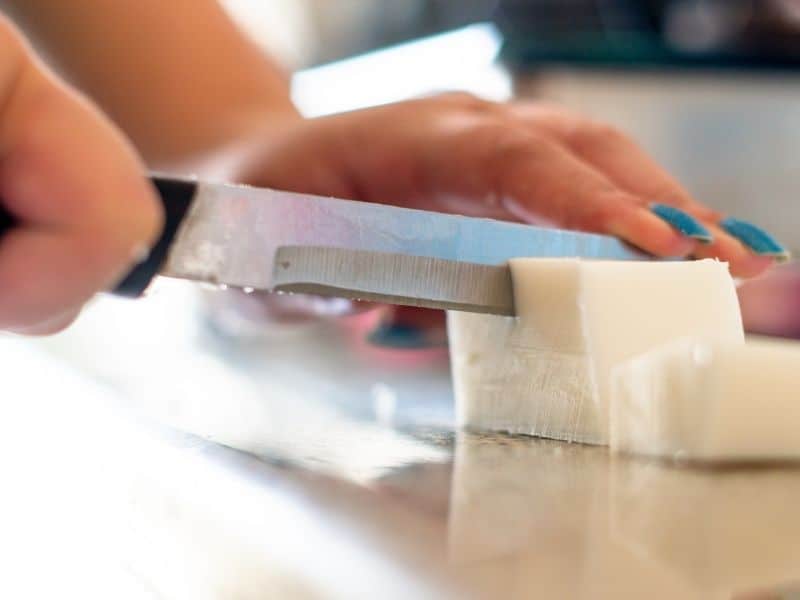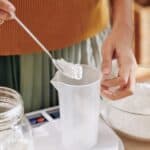Soap making is a great hobby, but it can be frustrating when your soap turns out too hard. In this article, we will discuss the causes of soap hardness and how to fix it. We will also provide tips on how to prevent soap hardness from happening in the first place.
Why Is My Soap Too Hard?
1) Using Too Much Lye
In most situations, lye heaviness is the primary cause of most people’s handmade soap becoming hard and crumbly. However, this is not the only explanation; there are several other things to consider as well, which we will discuss in detail below.
The reason for this is that the lye amount in the formula is wrong-maybe too much or too little usage.
It is the most typical reason for your soap’s hardness and crumbliness. Much of the time crumbly soap is caused by using too much lye in your soap formula. The term “lye-heavy” refers to the fact that the lye did not wholly convert to soap during saponification, leading to free-floating lye.
When you create homemade soap that feels crumbly or dry, you should check to see if it’s lye-heavy before using it or selling it. Since there are a variety of possible outcomes for those who use it, including dry skin, irritability, and even skin burns if you’re using it too much. There are indeed a variety of pH tests that may be used to determine whether or not the soap is lye heavy.
Use A Lye Calculator
If you’re making soap for yourself or selling, you’ll need to use a lye calculator to precisely determine the quantity of lye to put on your soap.
You may purchase this equipment online if you don’t already have it. It’s important to remember that all ingredients must be weighed on an exact scale while creating soap.
You don’t have to use volume-measured recipes (cups, tablespoons, teaspoons, etc.) Lye and oils should always be measured precisely rather than by such equipment.
Many inaccuracies and errors may occur when manufacturing soap; also, there are some really dangerous recipes on the internet that we have no control over.
Another possibility for this problem is that the scale you’re using is inaccurate.
Doublecheck Your Scale
There are a lot of times when your scale batteries are low. It’s common for scales to perform strangely and report incorrect numbers, potentially ruining your soap-making. To avoid this problem, make sure you have new batteries in your scale.
If you already have sufficient money, you may just use a high-quality digital scale, as the weights on a small cheap mechanical scale might be significantly different when compared to the weights on a digital scale.
2) Using Too Much Sodium Lactate
Using quite so much sodium lactate in soap can also cause it to become hard and crumbly.
Check Sodium Lactate Amounts
You must remember that one teaspoon of sodium lactate per pound of oil is sufficient in a soap formulation; you cannot simply add anything you want since perfect soap requires precise measurement. When the lye solution has already been warmed, you may add sodium lactate.
3) You Skipped Gel Phase
In many cases, soap that hasn’t gone through the gel phase might have various consistency issues at first. It might be hard and crumbly at the sides, or it can be overly soft.
Keep An Eye On Temperatures
Let the soap return to room temperature and remain undisturbed for another 24 to 48 hours before taking it from the fridge or freezer; keep in mind not to be too eager; otherwise, you will fail.
If you attempted to cut a bar and it crumbled or was still soft, you should let it remain in the open air for a few more days before trying to cut it again to ensure that it will not break.
4) Salt Bars
A salt bar is a type of soap composed primarily or entirely of coconut oil with a large amount of sea salt. If you want this type of soap, don’t be too slack while cutting it since it sets up rapidly, and if you cut it into bars too late, it will be pretty hard and crumbly.
Better Mold Selection
Individual silicone molds can be used instead of a typical loaf mold to make unmolding easier. If you have a loaf mold, you’ll need to keep an eye on the soap once it’s been poured into the mold.
You should cut it into bars as quickly as it sets up, which should be within a few hours of pouring; don’t wait until it gets too crumbly! If you don’t want your hands to be hurt, always use gloves because the soap is still toxic at around this phase.
5) Usage Of Hard Oils
Another cause of this issue is that you probably use a significant proportion of hard oils like coconut and salt in your formulation, which can cause the soap to harden and crumble quickly.
Cut The Soap At The Right Time
Always keep an eye on your soap, particularly throughout the first 6 hours, to see whether it’s genuinely developing or if it’s too soft or too firm. If you see that your soaps are starting to harden, you should cut them as soon as possible before they become too difficult to cut.
How Can You Prevent Your Soap From Getting Hard and Crumbly?
If the soap you’re making turns out to be hard and crumbly, you should try to cut it while it is still hot. For the next time you make a formulation, simply change the recipe to 30-40% liquid.
It would be best if you kept in mind that adding too little water can cause the soap to harden, making it difficult to manage and perhaps resulting in a failed soap-producing attempt. If you’re using hard oils, simply swap them out for more calming oils.
The cause of these problems is that hard fats are solid at room temperature and will cause the soap to harden as soon as it cools.
Last but not least, it is usually preferable to weigh all of the components you will be using while creating soap rather than measuring them in cups and tablespoons, which might be imprecise.
To avoid soap from unbalanced elements, make sure your scale is 100 percent accurate and replace the batteries.
Frequently Asked Questions
If your soap is too hard, you can try to cut it while it is still hot. For the next time you make a formulation, simply change the recipe to 30-40% liquid.
It would be best if you kept in mind that adding too little water can cause the soap to harden, making it difficult to manage and perhaps resulting in a failed soap-producing attempt.
One of the primary causes of soap getting hard and crumbly is adding too little water during the soapmaking process.
This can cause the soap to harden, it difficult to manage and resulting in a failed soap-producing attempt. Another cause of soap getting hard and crumbly is using too many hard oils in your formulation which will cause the soap to set up rapidly.
If you’re using hard oils, simply swap them out for more calming oils. Additionally, it is usually preferable to weigh all of the components you will be using while creating soap rather than measuring them in cups and tablespoons, which might be imprecise.
To avoid soap from unbalanced elements, make sure your scale is 100 percent accurate and replace the batteries. Lastly, always keep an eye on your soap, particularly throughout the first 6 hours, to see whether it’s genuinely developing or if it’s too soft or too firm. If you see that your soap is starting to harden, you should cut it as soon as possible before it becomes too difficult to cut.
Conclusion
In conclusion, there are a few things you can do to prevent your soap from getting hard and crumbly. One is to make sure you’re using the right proportion of liquids in your recipe.
Another is to swap out hard oils for more calming oils. Finally, always keep an eye on your soap, particularly throughout the first 6 hours, to see whether it’s genuinely developing or if it’s too soft or too firm.
If you see that your soap is starting to harden, you should cut it as soon as possible before it becomes too difficult to cut.






